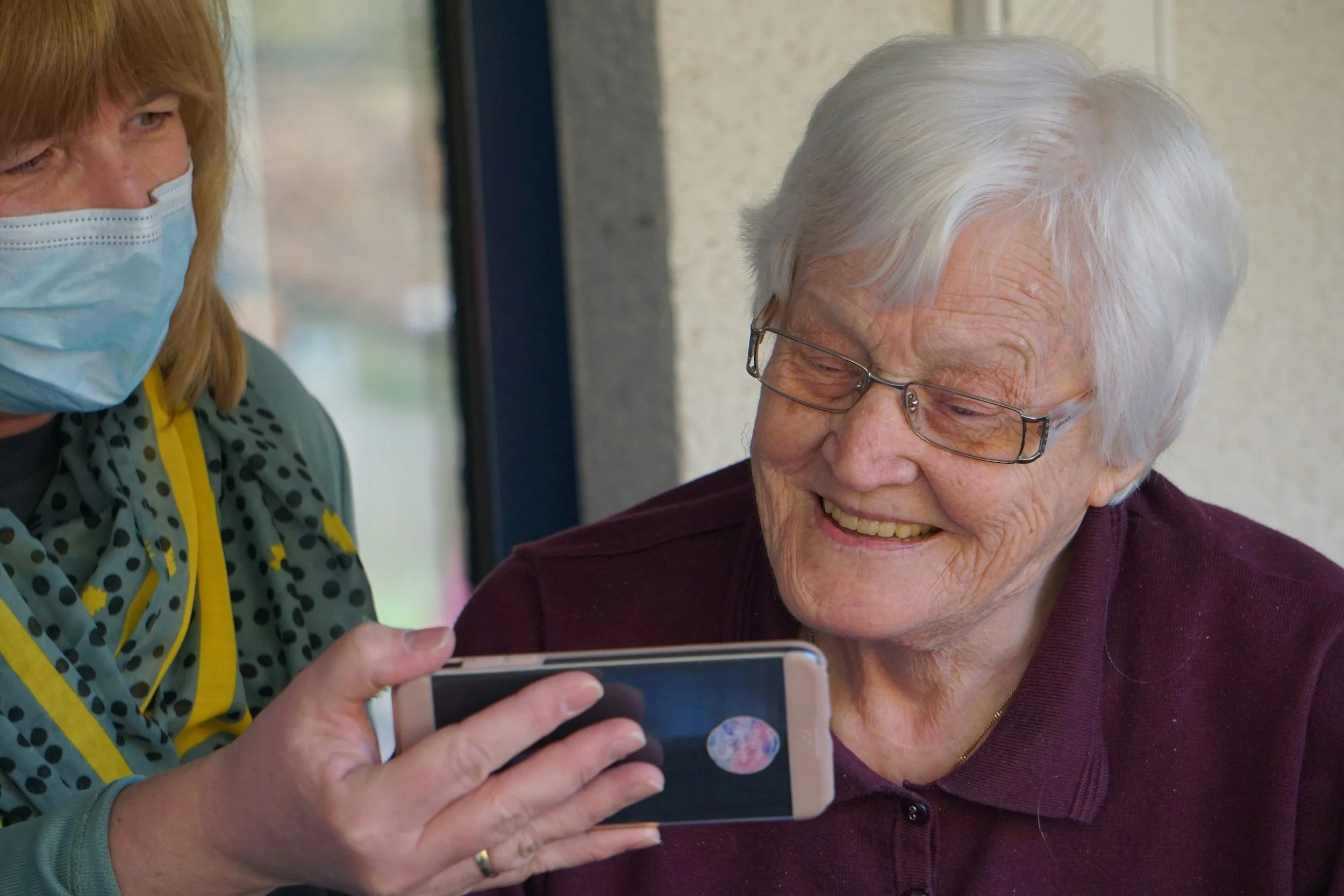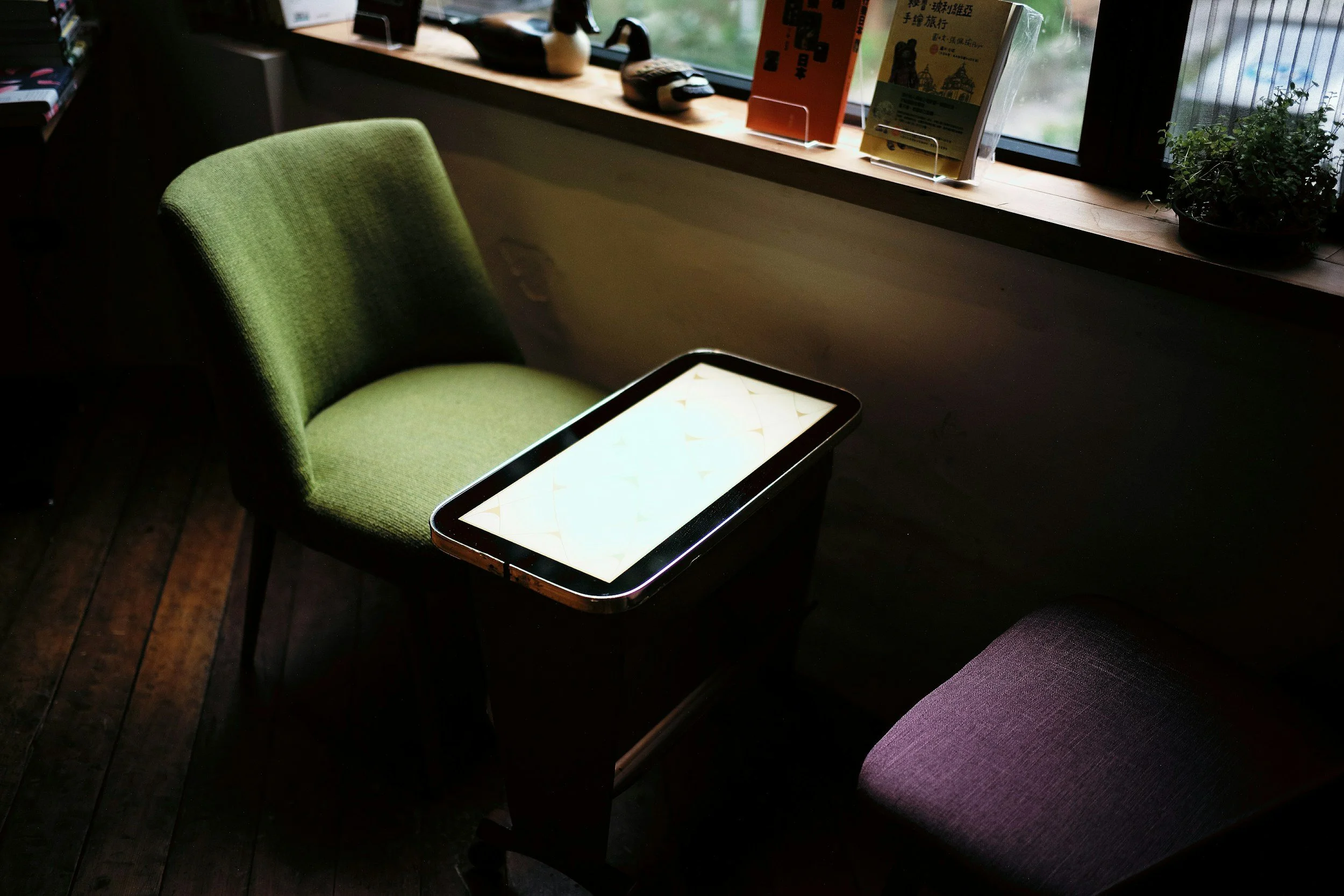AAC Support for Adults in South Florida (Augmentative and Alternative Communication)
When speech is limited or lost, communication doesn’t have to be.
Whether due to stroke, ALS, brain injury, or a progressive condition, speech therapy in Palm Beach County with AAC (Augmentative and Alternative Communication) provides a path forward — helping individuals express needs, make choices, and connect with others.
Nina offers in-home AAC evaluation, setup, and training to help adults and caregivers find and use the tools that work best for them. Below, you can learn about speech therapy with Nina and how AAC can help with your speech needs.
Get Started with AAC (Augmentative & Alternative Communication)
Complete this quick form and Nina will contact you within 24 hours to discuss your needs.
What Is AAC?
AAC stands for Augmentative and Alternative Communication — systems or tools that support or replace spoken language. AAC ranges from low-tech options (like pointing boards or picture cards) to high-tech devices (like speech-generating tablets and apps).
AAC is not a last resort — it’s a powerful tool that can restore independence and improve quality of life for anyone who has difficulty speaking clearly or consistently.
Who Needs AAC?
AAC can help adults who have:
Progressive conditions like ALS, Parkinson’s, or primary progressive aphasia (PPA)
Severe apraxia or dysarthria
Head and neck cancer affecting speech
Developmental disabilities that impact communication
Any condition where speech is lost or unreliable
AAC is often life-changing for people who:
Can’t speak clearly enough to be understood
Can only say a few words or sounds
Have fluctuating speech due to fatigue or illness
Feel frustrated or shut out in social or medical settings
Why AAC Is Important
AAC gives people a voice when verbal speech is unreliable. It reduces frustration, improves safety, enhances relationships, and restores dignity.
When introduced early, AAC can even support natural speech recovery by keeping communication pathways active.
What Does AAC Support Include?
Nina provides comprehensive in-home AAC services, including:
AAC evaluation — to determine the right tools for speech, physical ability, cognition, and lifestyle
Device and app selection — including tablet-based speech-generating devices and communication apps
Training sessions — for the user and caregivers to learn and practice
Low-tech options — such as communication books, yes/no boards, or picture-based systems
Caregiver education — to support daily communication routines
Ongoing support — to adjust systems and ensure continued success
AAC is always personalized — the goal is to find what works best for the individual’s needs, comfort level, and environment.
Types of AAC Nina Uses
Picture communication boards or books
Text-to-speech devices (e.g., iPads with AAC apps)
Speech-generating devices like Tobii Dynavox and Lingraphica
Letter boards or alphabet charts
Yes/No switches
Custom low-tech tools for specific needs (home, hospital, daily tasks)
No matter the tool, the goal is the same: to help people say what they need to say — whether that’s a basic request or a full conversation.
Adults Using AAC in Palm Beach County: Supporting Communication Independence
Augmentative and Alternative Communication (AAC) serves as a vital bridge for adults in Palm Beach County who face communication challenges due to various conditions. From stroke survivors relearning to express themselves to individuals with autism, cerebral palsy, or degenerative neurological conditions, AAC provides pathways to meaningful communication that enhance independence, social participation, and quality of life.
Understanding Adult AAC Needs
Adults in Palm Beach County who benefit from AAC represent a diverse population with varying communication needs. Some acquired communication difficulties later in life due to stroke, traumatic brain injury, or progressive conditions like ALS or Parkinson's disease. Others have used AAC since childhood and continue to rely on these tools as adults. The key is recognizing that communication needs change throughout life, and AAC solutions must adapt accordingly.
Unlike children who are developing language skills, adults using AAC often have established linguistic knowledge but need alternative ways to express their thoughts, feelings, and needs. This distinction is crucial for service providers and family members who support adults with communication differences.
AAC Technologies and Tools Available
The landscape of AAC technology has evolved dramatically, offering Palm Beach County residents numerous options. High-tech solutions include tablet-based communication apps like Proloquo2Go, TouchChat, and LAMP Words for Life, which transform everyday devices into powerful communication tools. These applications offer customizable vocabulary, voice output, and the ability to create personalized messages quickly.
Low-tech AAC options remain equally important. Communication boards, picture cards, and written communication tools provide reliable alternatives that don't depend on batteries or technology. Many adults use a combination of high-tech and low-tech approaches, selecting the most appropriate tool for each situation.
Speech-generating devices (SGDs) represent another category of AAC tools. These include speech generating devices that can be programmed with personalized vocabulary and voices, allowing adults to maintain their communication style and personality even when their natural speech is affected.
Workplace Integration and Advocacy
For working adults in Palm Beach County, integrating AAC into professional environments requires both technological solutions and workplace advocacy. Many employers are learning to accommodate AAC users through assistive technology, modified communication protocols, and increased awareness of communication differences.
The Americans with Disabilities Act provides legal protections for adults who use AAC, ensuring reasonable accommodations in employment settings. This might include providing AAC devices, allowing extra time for communication, or offering alternative formats for meetings and presentations.
Social and Community Participation
AAC enables Palm Beach County adults to participate fully in community life, from grocery shopping and medical appointments to social gatherings and recreational activities. Many adults find that having multiple AAC options available increases their confidence in various social situations.
Support groups and community organizations play crucial roles in helping AAC users connect with others who share similar experiences. These networks provide practical advice, emotional support, and advocacy opportunities that strengthen the entire AAC community.
Funding and Insurance Considerations
Accessing AAC technology often involves navigating complex funding systems. Medicare, Medicaid, and private insurance may cover AAC devices and services under certain circumstances, though the approval process can be lengthy and require extensive documentation from speech-language pathologists and physicians.
Florida's Assistive Technology Program provides additional resources for individuals seeking funding for AAC devices. Understanding these systems helps adults and their families make informed decisions about AAC investments.
Training and Ongoing Support
Successful AAC implementation extends beyond device selection to include comprehensive training for both the AAC user and their communication partners. Family members, friends, coworkers, and caregivers all benefit from understanding how to communicate effectively with AAC users.
Comprehensive rehabilitation services, including specialized speech therapy, are tailored for adults and seniors, supporting individuals dealing with voice disorders to communication and swallowing challenges. This holistic approach recognizes that communication difficulties often intersect with other health and wellness concerns.
Future Directions and Innovation
The field of AAC continues to evolve rapidly, with advances in artificial intelligence, voice recognition, and mobile technology creating new possibilities for adult AAC users in Palm Beach County. Eye-gaze systems, brain-computer interfaces, and predictive text technologies are expanding options for individuals with severe physical limitations.
As awareness of AAC grows within the Palm Beach County community, more opportunities emerge for adults to access appropriate communication support. Healthcare providers, employers, and community organizations are increasingly recognizing the importance of communication access and working to create more inclusive environments.
The journey of using AAC as an adult involves continuous learning, adaptation, and self-advocacy. With proper support, training, and access to appropriate technology, adults in Palm Beach County can maintain meaningful communication throughout their lives, participating fully in their communities and achieving their personal and professional goals.
In-Home AAC Therapy in Palm Beach County
Nina offers AAC evaluation and support at home, allowing clients to test and practice tools in the setting where they actually need to communicate. She serves adults across:
Delray Beach and surrounding areas
Book a Free AAC Consultation
If you or a loved one is struggling to speak, AAC tools can provide a way forward, not just for communication, but for confidence, connection, and control.
Call (561) 797-2343 or fill out the Contact Form to schedule your free consultation.
Everyone deserves a way to be heard. Let’s find yours.
Frequently Asked Questions: AAC (Augmentative and Alternative Communication)
What is AAC?
AAC stands for Augmentative and Alternative Communication. It includes all forms of communication other than spoken words — such as picture boards, speech-generating devices, communication apps, or even gestures and writing — used to help individuals who have trouble speaking.
AAC can either augment natural speech or replace it when speech is limited or absent.
Who needs AAC?
AAC can benefit any adult who has difficulty speaking clearly or consistently, including those with:
Primary Progressive Aphasia (PPA)
Apraxia or dysarthria
Head and neck cancer
Developmental disabilities affecting speech
AAC is also useful for individuals with fluctuating speech due to fatigue, neurological illness, or progressive loss of function.
Is AAC only for people who can’t speak at all?
No — AAC is often used by people who can speak a little, but whose speech isn’t reliable enough to meet their communication needs.
AAC can help people who:
Struggle to get words out under stress
Are hard to understand due to slurred or weak speech
Speak inconsistently or lose speech during illness or fatigue
Use a few words or sounds but want to say more
AAC tools support speech, not just replace it.
What kinds of AAC systems are available?
AAC systems range from low-tech to high-tech, including:
Picture communication boards
Letter or word boards
Yes/No charts or switches
Text-to-speech apps on tablets or phones
Dedicated speech-generating devices (SGDs)
Writing tools or notebooks with key phrases
Nina helps determine the best system based on speech ability, physical skills, cognitive function, and lifestyle.
How do you choose the right AAC system?
Nina conducts an AAC evaluation to assess:
Communication needs
Speech clarity and consistency
Motor skills (can the person touch or point?)
Cognitive and visual abilities
Daily routines and environments
From there, she recommends tools that fit the individual and provides hands-on training and support.
Will AAC stop someone from trying to speak?
No — research shows the opposite. AAC can actually encourage natural speech by reducing frustration, creating success in communication, and stimulating language areas of the brain.
For people with aphasia after a stroke, apraxia, or progressive speech loss, AAC keeps communication open — which may improve or preserve verbal abilities.
Do you help with setting up devices or apps?
Yes. Nina provides:
In-home AAC setup
Training for both the user and caregivers
Practice in real-world situations
Follow-up visits to update or adjust tools
She works with a wide range of apps and platforms, and can also collaborate with your neurologist, rehab team, or durable medical equipment provider if needed.
Can family members use AAC tools to help?
Absolutely. Family and caregivers are a key part of successful AAC use. Nina teaches:
How to prompt and support AAC communication
How to avoid overwhelming the user
How to use AAC tools in natural conversation
Ways to reinforce language during meals, care tasks, or social activities
AAC works best when it’s part of daily life — not just therapy sessions.
Do you support clients with progressive conditions like ALS or PPA?
Yes. Nina helps individuals with ALS, Parkinson’s diagnoses, and Primary Progressive Aphasia:
Select AAC tools before speech is lost
Train early for smoother transitions
Use both voice and text-based options
Adjust systems as speech and motor needs change
Early intervention makes a huge difference in long-term communication.
What other speech therapy services do you provide?
Cognitive-Communication Therapy – Improves memory, focus, reasoning, and problem-solving skills after illness, injury, or neurological changes.
Speech Production & Articulation Therapy – Makes speech sounds clearer and easier to understand.
Language Therapy (Aphasia, etc.) – Restores speaking, understanding, reading, and writing skills impacted by stroke, brain injury, or other conditions.
Voice Therapy – Strengthens and improves voice quality, pitch, and endurance.
Swallowing Therapy (Dysphagia) – Builds swallowing strength and teaches safe eating and drinking techniques.
Reading & Writing Support – Helps rebuild literacy skills lost or reduced due to neurological changes.
Functional Communication Skills – Develops practical communication for home, work, and social settings.
Progressive Disease Communication Support – Maintains and adapts communication abilities for conditions like Parkinson’s, ALS, and dementia.
What areas do you serve?
Nina provides in-home AAC therapy and support throughout Palm Beach County, including:
Speech therapy in West Palm Beach
Boca Raton speech-language services
Lake Worth communication therapy
Manalapan speech therapy for adults
Lantana speech and language support
Palm Beach at-home speech therapy
Delray Beach speech-language therapy and surrounding areas
How do I get started?
Nina offers a free phone consultation to understand your needs and determine the right next steps for AAC support.
Call (561) 797-2343 or fill out the Contact Form to schedule your consultation.
Let’s take the next step together.
If you or a loved one is facing communication or swallowing challenges, we’re here to help. Fill out the form below and we’ll contact you within 24 hours to discuss your needs and schedule your first session.




